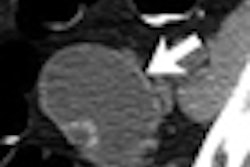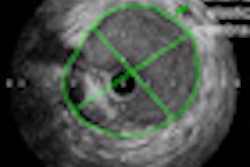For children with traumatic brain injuries potentially serious enough to warrant a head CT scan, a small change in the clinical guidelines used to perform follow-up head CT led to a significant drop in rescan rates and costs -- all without any apparent increase in the risk of serious injury.
Traumatic brain injury (TBI) in children accounts for more than $1 billion annually in healthcare costs in the U.S. In the absence of clear guidelines regarding the use of CT imaging, many children with these injuries may be exposed to excessive radiation doses, according to principal investigator Richard Falcone, MD, from Cincinnati Children's Hospital Medical Center, and colleagues.
"Our institution, as well as almost all other institutions, likely over-image children during initial evaluations and subsequent care," Falcone said in a statement. "There is an increased risk of cancer with imaging, and therefore, less imaging is better."
The retrospective study, presented on Sunday at the American Academy of Pediatrics (AAP) meeting in San Francisco, was made possible by a rule change implemented in July 2008 at Cincinnati Children's Hospital Medical Center that allowed clinicians to forgo a second follow-up head CT scan in children with injuries rated 13 to 15 (mild) on the Glasgow coma scale.
Previous studies have looked at ways to eliminate the first scan in children with head injuries, but this study examined the need for a second scan in those with injuries serious enough to warrant a first CT.
"This was a small, select group of patients," Falcone said in an interview with AuntMinie.com. "We looked at only those kids who qualified for that first head CT scan, then got admitted."
In all, the team examined 712 patients with mild traumatic brain injuries over the four-year study period. The patients, ranging in age from infants to 16 years of age, were seen in the emergency room for blunt head trauma. The guidelines were developed by trauma doctors and nurses, along with their peers in neurosurgery.
The most common injuries in the cohort were "falls; unfortunately, some child abuse cases; and car accidents," Falcon said. The reason a second CT scan was even considered in this patient cohort was that there might have been some small abnormality on the initial scan -- small subdural hematoma or epidural contusion, for example -- that had at least the potential to worsen.
"Our goal was not to change procedures for the initial scan, but only to say, for those who got the screening, what happens to them afterward?" he said. "And we did increase the number of those who were able to get discharged who probably would have gotten admitted before. ... We still had standard discharge instructions for coming back in case things worsened."
Patients were divided into two groups with regard to implementation of the new guideline. Group 1 included 389 patients presenting with a level I blunt trauma between July 1, 2006, and June 30, 2008; group 2 included 194 patients presenting during the postguideline period between July 1, 2008, and June 30, 2009.
The guidelines categorized patients as high, low, or normal risk following an initial head scan. When the guidelines for follow-up scans were in place, researchers found a reduced number of scans, fewer overall days in hospitals and intensive care units, and lower charges by about $8,000 per patient.
The study found no significant differences in the mechanism of injury, injury severity, insurance status, or race/ethnicity between the two groups. However, there were significant reductions in overall hospital charges, length of hospital stay, and the number of head CT scans performed.
|
||||||||||||||||
| Data courtesy of Richard Falcone, MD, and colleagues. |
In addition to reducing the risk of cancer, less imaging also translated into fewer charges and a shorter length of hospital stay. The cost analysis relied on hospital charges, "which may not be the perfect metric but was consistent across the whole time period," Falcone said.
What changed was the ability to streamline the decision-making process and make it more consistent, he said.
"This is now our policy for all these kids: We have it posted on our website, we have it in the resident handbook, and it's in the guidelines in the [emergency department] and on the primary floor where we take care of these patients -- so it's pretty well integrated," Falcone said.
In addition, performing fewer CT head scans cuts healthcare costs and affects patient satisfaction as well.
"We got them out of the hospital faster, reduced their radiation dose and therefore their cancer risk, and saved money all at the same time while making the parents happier and less frustrated -- and, most importantly, not missing any injuries or not having any kids come back because we didn't scan them," Falcone said.
Future and more widespread implementation of such guidelines can continue to improve overall care for injured children, the authors said in an abstract accompanying the study.
As for the future, the investigators plan to implement routine follow-up communication with patients and families rather than just tracking returns to the facility for care -- though Falcone said he is pretty confident that patients needing more care would tend to return to the facility due to a lack of pediatric emergent care alternatives in the region.
In fact, the complete lack of return visits or complications in the cohort means that even more might be done to reduce unnecessary pediatric scans, he added.
"It raises the question, at least, that maybe there can be still fewer scans and we can reduce them even further," he said. "It's really a small minority of kids that need this repeat scan, and our feeling is that there's still maybe too many kids getting a scan."
By Eric Barnes
AuntMinnie.com staff writer
October 6, 2010
Related Reading
Emergency CT scans may delay pediatric patient transfers, August 6, 2010
Portable CT scanner recommended for pediatric ICU studies, May 10, 2010
Pediatric CT dose is low but varies widely in Belgium, April 23, 2010
320-row CT minimizes dose in pediatric abdominal studies, March 3, 2010
CATCH rules accurately predict which kids need head CT, February 9, 2010
Copyright © 2010 AuntMinnie.com



















